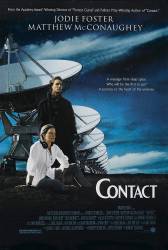Factual error: The geography around the VLA in New Mexico is actually relatively flat - in fact one of the reasons why the array complex is there is because the land is flat. The canyon in the film was actually Canyon de Chelly, in Arizona, more than 170 miles (270 km) away. But in the film, when Ellie goes to the canyon, the radio antennas seem to be right there, insinuating that the canyon is part of the VLA's magical desert scenery.

Contact (1997)
Ending / spoiler
Directed by: Robert Zemeckis
Starring: Matthew McConaughey, John Hurt, Jodie Foster, Tom Skerritt, David Morse, Jena Malone, Geoffrey Blake
A religious fanatic with a bomb strapped to his body breaches security and destroys the transport machine. Dr. David Drumlin, who was chosen over Ellie to make the trip, is killed. Unknown to Ellie, the U.S. government secretly built a second transport machine on Hokkaido Island in Japan. She is chosen to go and travels through a wormhole to Vega. There she meets an alien who appears to her in the guise of her dead father. He tells her that his species did not build the machine, but it was already there when they arrived. Many other species have made contact. Ellie wants to stay and learn more but the alien sends her back, telling her that in time humans will take another step in communicating with them. Ellie returns to Earth. From her perspective the trip lasted about 18 hours, but from the point-of-view of those on Earth, she never left and was only out of contact a few seconds earth time. Not a trace of data was videotaped to prove her trip was real, and many consider her story a hallucination and the machine a total flop. Even Ellie concedes it may not have happened--except the video recording doesn't show seconds of static, but about 18 hours of it. Where was she during that time?
ciphoid_9
Palmer Joss: What are you studying up there?
Ellie Arroway: Oh, the usual. Nebulae, quasars, pulsars, stuff like that. What are you writing?
Palmer Joss: The usual. Nouns, adverbs, adjective here and there.
Trivia: Filmmakers George Miller and Francis Ford Coppola both sued Warner Bros. over Contact. George Miller sued for breach of contract (as he was the original director before being fired and replaced by Robert Zemeckis), while Coppola sued because he claimed that he and Carl Sagan (the writer of Contact) had already developed the premise for a TV show in the 1970's which was never produced, before Sagan later used the idea for Contact in 1985. Both suits failed - Miller's firing was within contract and perfectly reasonable, and Coppola was dismissed (twice) because he had taken far too long to sue the company (if he sued when Sagan began working in the 80's, he may have won, but he waited until after the film's release in 1997 to sue).
Question: If you read the book version of Contact you know that the stuff about transcendental numbers and the Artist's Signature was left out of the movie. This makes no sense to me, since it's not only the real ending, it's the whole POINT of the story. Without this information, the story's fundamental question (does God exist?) is not answered in the movie. Does anyone know why this was left out?
Answer: The film chooses to focus on Ellie's personal journey and how she deals with and comes to terms with what happens - it doesn't really involve God at all, other than the inclusion of Palmer Joss as a religious advocate, choosing to restrict itself to the much less theologically controversial theme of a straight first contact scenario, without the religious overtones. Given the depth of feeling on religious matters in the US, it's hardly surprising that the filmmakers preferred to leave this particular hot topic out. While Carl Sagan died during production of the film, he both co-produced and was involved in the story process, so he was clearly not concerned about this change.
Join the mailing list
Separate from membership, this is to get updates about mistakes in recent releases. Addresses are not passed on to any third party, and are used solely for direct communication from this site. You can unsubscribe at any time.
Check out the mistake & trivia books, on Kindle and in paperback.




Answer: If anything, I think the film's producers deliberately left godly topics unaddressed (and questions dangling, unanswered) because they didn't want to alienate any particular audience. However, we know the producers of "Contact" certainly did vilify religion through the sinister scenes with Joseph, the evangelical extremist. At the same time, the film created empathy for the president's glib theological adviser, Palmer Joss. So, I don't think the film was shying away from religious topics, and I think it was pretty fair to the religious viewpoint, for the most part. But this movie wasn't about religion; it was about a primitive, materialistic, self-centered and aggressive species (humanity) reluctantly acknowledging the existence of vastly more intelligent and even godlike entities throughout the cosmos. Even the first-contact entities, advanced as they are, acknowledge other entities much more ancient and much more advanced (the virtual architects of the space/time conduit). The implication was that we live in a universe that may be populated with many intelligent entities that answer every human criteria of godhood. Ellie's narrow-minded atheism was surely shaken to its foundation by her experience; and, while she didn't "convert" to archaic earthly religions, she was spiritually a different person upon her return. The film, however, is open-ended and fence-straddling and doesn't presume to definitively answer the question of the existence of god, leaving it up to the audience to decide.
Charles Austin Miller